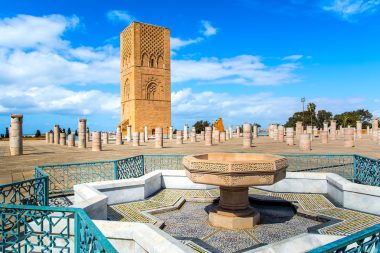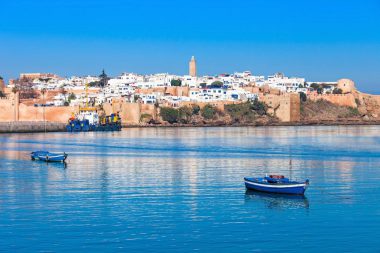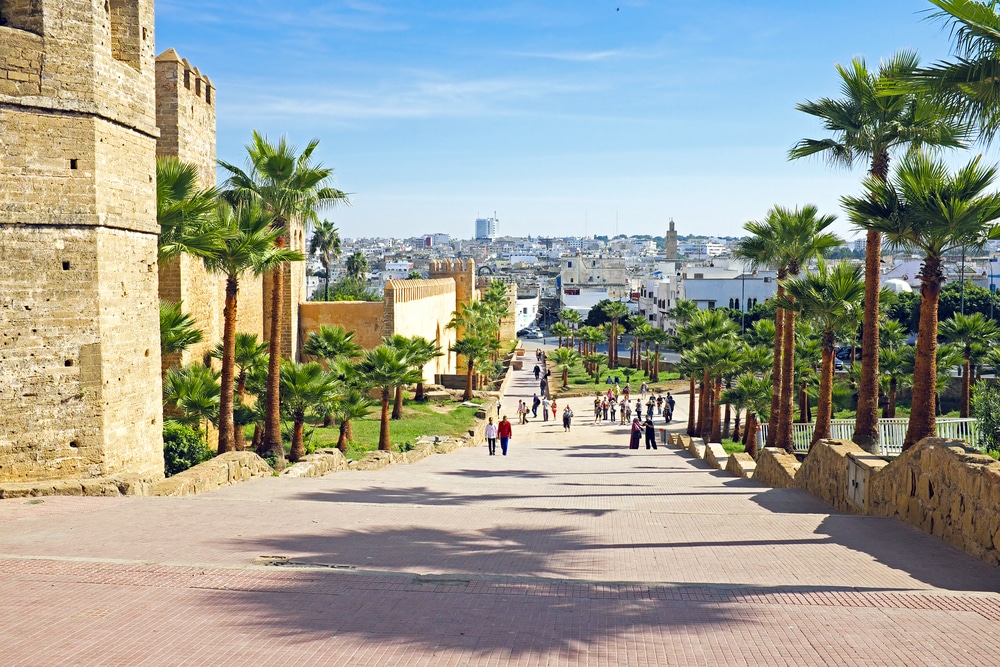Morocco The capital Rabat is a metropolis full of fascinating impressions. In many areas, Rabat is a vibrant city whose atmosphere is shaped by a diverse, colorful and modern society. But at every turn you come across the witnesses of a long and eventful history. The city’s location on the Atlantic Ocean, but not far from the Strait of Gibraltar and the Mediterranean Sea, has always attracted many conquerors, sailors and merchants.
As early as 800 years before Christ, Phoenician merchants built a trading post here. Roman emperors turned the port town on the edge of the then known world into a flourishing small town. At the turn of the first millennium, the teachings of Islam were introduced and numerous caliphs took turns as rulers. In addition to Rabat, the cities of Fez, Marrakech, and Meknès also became so-called royal cities, where the rulers of various dynasties built their palaces.
Under Spanish influences, Rabat became an important overseas port, visited by hundreds of ships from all nations of Europe. At the beginning of the 19th century, the city was increasingly shaped by French politics and culture. Morocco became independent in 1956. The constitution of the new state is a constitutional monarchy and Rabat is now not only the capital, but once again a royal city.
Great impressions while strolling through a fascinating city
Rabat is divided into various areas of tourist interest, the origins of which lie in very different eras. There is the Arab old town, the Moorish fortress Kasbah of the Oudayas, the Hassan district with the tower of the same name, the mausoleum of Mohammed V and the royal palace Mischua. A completely different cityscape is offered by the Ville Nouvelle, the modern, French-influenced new town. A stroll through the city should also include a visit to the venerable and mysterious necropolis of Chellah.
The lively streets of the medina

The medina, the old town of Rabat, is enclosed on three sides by a high wall. Inside, you will encounter a symmetrically arranged maze of alleys with a lively, exotic atmosphere. A variety of merchants delight with a rich range of food, spices, clothing and souvenirs. It is the right place to buy a beautiful and original souvenir of visiting Rabat.
The Kasbah of the Oudayas
Not far from the medina rise the mighty fortress walls of the Kasbah of the Oudayas. The fortress dates back to the 12th century and has been designated by UNESCO as part of the World Heritage Site. Behind the Moors, a picturesque district awaits the visitor, which is also called the “city within the city” by its inhabitants. There is a small park in Andalusian style and some very interesting museums. The handicraft collection of the Musée des Oudaïas is particularly worth seeing. In the middle of the Kasbah is also the oldest mosque in the city, the Jama al Atiq. The almost 1,000-year-old building was extensively restored in the 18th century. In many places in the Kasbah of the Oudayas you can enjoy a great view of the mouth of the Bou-Regreg River, the beaches, port facilities and the neighboring town of Salè on the opposite bank of the river. A nice place for a rest is the nearby Café Maure, which is more than 100 years old.
Rabat’s landmark: The Hassan Tower
The unmissable focal point of the Hassan district is the 44-metre-high Hassan Tower. The square building has an edge length of 16 m and was intended to become a huge minaret in the early 12th century, to the top of which you could ride up with a horse. Unfortunately, the tower and the associated mosque were never completed. The fragments of walls and columns on the square in front of the tower give an idea of the gigantic size of this sacred building. Only a few meters away is the mausoleum of Mohammed V. He was the first Moroccan king after independence from the French colonial era. His son King Hassan II has also found his final resting place here.
The Chellah Necropolis
A very special place is the necropolis, the “city of the dead” Chellah. Through a gate flanked by two massive towers, one enters the area enclosed by high walls. In 13. and In the 14th century, numerous important personalities, nobles and religious leaders were buried here. The tomb of Sultan Abu l-Hasan, who was buried here in 1351, is well preserved and worth seeing. After a walk through a well-kept park, you will reach the ruins of the Roman settlement of Sala Colonia. They were discovered in the 1930s and carefully exposed. The
The surviving remains of the walls of residential buildings and shops show how everyday life was in antiquity.
Art and culture in Rabat

A complex insight into Moroccan history from Roman times to the present day is provided by the Musée Archéologique in the Ville Nouvelle, the new town. Just a few steps away, the Musée Mohammed VI d’art moderne et contemporain inspires with its Moorish façade and a highly interesting collection of art and paintings from different eras.
The beaches of Rabat
If you are looking for refreshment after a stroll through the city and sightseeing, you will be thrilled by the extensive beaches of the city. Directly in the city area, near the Kasbah des Oudayas, are the beaches Temara and Skirat. At the “Plage des Nations” you will even find good opportunities for surfing.


